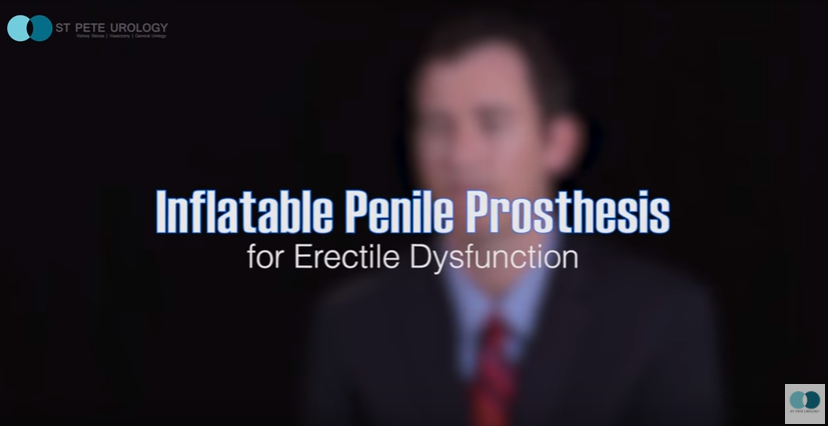Erectile dysfunction (ED) is a common problem, affecting up to 52 percent of all men at some point in their lives. Statistically, ED is found in 20 percent of men over the age of 20, 40 percent of men over 40 and 78 percent of men over 75. As a general marker of cardiovascular function, erectile dysfunction tends to occur more frequently in men with obesity, diabetes, high blood pressure, current smoking history, diabetes, heart disease or who are taking medications that impede cardiovascular function. In most men with ED, the problem can be successfully treated with prescription medications (pills) or a penis pump (a vacuum constriction device). However, in cases where pills and penile pumps prove ineffective, a penile implant surgery may be recommended as a last resort.
What is a penile implant?
A penile implant (also called penile prosthesis) is a medical or prosthetic device that is surgically placed and customized inside the penis and scrotum to help a man to achieve a natural-feeling and natural-looking erection, thereby gaining sexual function. It is an ideal treatment of erectile dysfunction in men who are not candidates for other ED treatments, have not been able to achieve an erection after other treatments, or have specific medical conditions such as peyronie’s disease ( a condition characterized by scarring inside the penis resulting in curved painful erections). Nevertheless, doctors usually prefer to start with the simpler, less invasive treatments for ED before opting for penile implant surgery.
Types of penile implants
There are three main types of penile implants: the three-piece inflatable pump, the two-piece inflatable pump and the semi-rigid, non-inflatable implant (malleable rods).
1. Three-piece inflatable pump
Also called the multi-component penile implant, the three-piece pump delivers the most natural, comfortable and rigid erection and offers the most suitable flaccidity when deflated. It is a larger and softer pump that is very easy to inflate by squeezing the pump and to deflate by pressing the release value above the pump. During the operation to implant the three-piece inflatable pump, two cylinders are placed in the penis, a fluid-filled container is implanted in the abdomen and an inflatable pump placed inside the scrotum. These three components are then connected using special tubing. To achieve an erection, the pump located in the scrotum is pressed to allow fluid to move from the abdominal container into the penile cylinders. Squeezing the release valve ensures that the fluid leaves the cylinders and moves back to the containers, making the penis flaccid.
2. Two-piece inflatable pump
For men with limited agility, such as those with trouble using their hands or with arthritis, the two-piece inflatable pump is ideal. Similar to the three-piece inflatable pump, the two-piece device works in the same way except that the fluid is kept in the pump located in the scrotum and not in a container in the abdomen (as with the three-piece pump). While the two-piece inflatable device is simpler and easier to place than the three-piece device, it is smaller, more difficult to inflate and offers a less-rigid erection than the three-piece pump.
3. Semi-rigid non-inflatable penile implant (malleable rods)
In some cases, the surgeon may insert two flexible rods into the penis to improve its rigidity. Once inserted, the rods will not change their stiffness or size and will keep the penis in a semi-rigid state. Typically, these rods are bent downward during implantation, but can be straightened upward or set in any other manner necessary for sexual intercourse. Non-inflatable implants can be inserted even by doctors with limited experience because they involve the simplest surgical procedure. They are completely concealed in the body and are a great option for men with limited dexterity, such as those with arthritis or problems using their hands. While malleable penile rods are very easy to use, their constant rigidity may make them uncomfortable.
Factors considered when selecting a penile implant
In order to achieve optimum results with penile implants, the needs and preferences of the patient must be carefully considered. So before doing an implant, the doctor will consider:
- (a) Age of the patient and of his partner.
- (b) Overall penile length and scrotum size.
- (c) Patient’s body size and type.
- (d) Ratio between the pendulous penis and crus (buried) penis.
- (e) Size of glans penis.
- (f) Any history of penile implant and previous pelvic or abdominal surgery.
- (g) Whether the penis is circumcised or not.
- (h) Presence of colostomy or previous kidney transplant.
- (i) Overall health and well-being of the patient.
- (j) Life expectancy of the patient.
Even though penile implants enable men to achieve an erection, they do not boost sexual sensation or desire. Most penile implants also will not make the penis larger or bigger than its natural size at the time of surgery. For some men, the penis may even be slightly smaller or shorter than it was before the procedure.
At St Pete Urology, our multi-dimensional and compassionate approach can be trusted to deliver excellent outcomes for all men with erectile dysfunction. For every man who comes to us, we identify the risk factors, assess the degree of dysfunction and recommend a safe and effective treatment. Apart from lifestyle modifications, medications and vacuum constriction devices, we also conduct safe penile implant surgery whenever necessary. We are committed to improving the sexual function and quality of life for all our patients. So do not suffer silently when we can provide effective solutions to your problem. For more information on prevention, diagnosis and treatment of ED, visit the”St Pete Urology” site.



 It’s possible. Research published in January 2016 found that men who ate foods high in antioxidants called flavonoids had a lower risk of
It’s possible. Research published in January 2016 found that men who ate foods high in antioxidants called flavonoids had a lower risk of 

